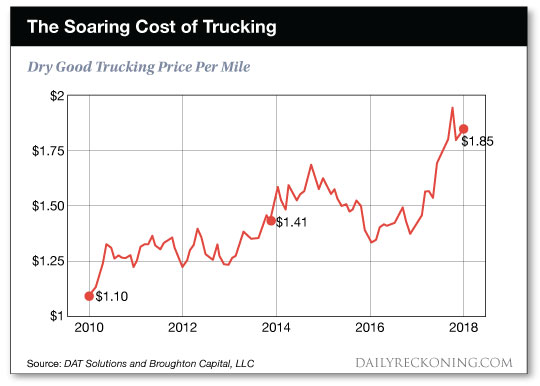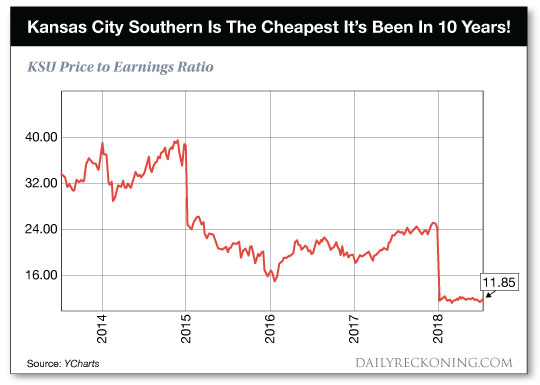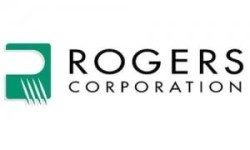The first quarter of 2018 was a strangely quiet one for oil and gas midstream operator Enterprise Products Partners (NYSE:EPD). Typically, the company announces at least a couple of new projects each quarter to grow the business and fuel its distribution to shareholders. Apparently, it was saving most of its project announcements for this past quarter as management added $600 million to its capital expenditure guidance for the year.�
Let's take a look at Enterprise's most recent earnings results and some of the new projects that management found too compelling to turn down.�

Image source: Getty Images.
Enterprise Products Partners' results: The raw numbers| Gross operating margin | $1.48 billion | $1.59 billion | $1.38 billion |
| Net income | $687 million | $912 million | $666 million |
| Diluted EPS | $0.31 | $0.41 | $0.30 |
| Distributable cash flow | $1.43 billion | $1.39 billion | $1.05 billion |
DATA SOURCE: ENTERPRISE PRODUCTS PARTNERS EARNINGS RELEASE. EPS = EARNINGS PER SHARE.
For a company that has a reputation as a slow-growing business, Enterprise's growth over the past year or so has been off the charts, with its reported 36% year-over-year jump in distributable cash flow. That increase is a result of several new projects starting commercial operations this past quarter including its propane dehydrogenation (PDH) petrochemical plant, a natural gas processing facility in the Permian Basin, and a natural gas liquids fractionator facility. As these facilities ramp up to full capacity, we should expect even better results.
The one stain on its earnings report was a $322 million, or $0.15 per share, noncash loss related to some crude oil futures contracts. Those mark-to-market�losses, part of fair value accounting practices, are why its crude oil services segment posted a significant decline compared to the prior quarter. Absent those charges, all four of its business segments posted considerable gains.�

Data source: Enterprise Products Partners earnings release. Chart by author.
What happened with Enterprise Products Partners this quarter? Total capital expenditures were $983 million for the quarter, which was down slightly compared to the first quarter. That is to be expected, though, as Enterprise brought $1.4 billion in projects into service in the first half of the year. However, management increased its capital spending guidance to�$3.8 billion to $4.0 billion for growth projects, up from�$3.2 to $3.4 billion in the third quarter. The increase in capital spending came after several new project announcements. The most recent string of investments have been heavily weighted toward processing and export facilities, but this past quarter management announced a slew of new projects to expand pipeline capacity for several of its existing projects. It announced a 100,000-barrel-per-day expansion of its Front Range and Texas Express pipelines to deliver growing natural gas liquid production from the Denver-Julesburg�shale basin in Colorado to its storage and petrochemical manufacturing hub in Mont Belvieu, Texas. It intends to reactivate a previously idle natural gas pipe that will deliver from the Barnett shale�formation to a supply hub in Sweeney, Texas. Also, it plans to develop an offshore crude oil export terminal that will be able to fuel Very Large Crude Carriers (VLCCs). Increased distributable cash flow resulted in a distribution coverage ratio of 1.5 times and produced�$491 million in excess cash, which Enterprise intends to use to fund a significant portion of this massive capital spending program over the next 18 months. What management had to sayAs part of the company's press release statement, CEO Jim Teague highlighted a couple of the major capital projects recently brought into service and the impact of it had on the bottom line.�
Our PDH facility, which completed commissioning activities and began commercial service in the second quarter, operated at full capacity. The�Midland-to-ECHO crude oil pipeline averaged 545 thousand barrels per day of gross transportation volumes from the�Permian Basin. In total, our liquid pipeline volumes were a record 6.2 million barrels per day and our marine terminal volumes were a record 1.7 million barrels per day.
This operational performance generated record distributable cash flow, excluding proceeds from asset sales, of�$1.4 billion, which provided 1.5 times coverage of our distribution for the quarter. We retained�$491 million�of distributable cash flow to reinvest in the growth of the partnership, which supports our goal of self-funding the equity portion of our growth capital investment.
You can read a full transcript of Enterprise's conference call here.�

EPD data by YCharts
Ready for the next roundBack at the end of last year, Enterprise's management announced that it was slowing down its distribution growth rate. The aim of the decision was to free up more excess cash to reinvest in the business and become less reliant on issuing equity as a source of funding. This past quarter shows why this was a good decision. The company now has a backlog of construction projects totaling $5.2 billion it expects to complete by the end of 2019. It goes to show the immense investment opportunities in U.S. energy infrastructure over the next several years. With all that retained cash, don't be surprised if we see even more projects get added to the mix over the next several months.
 1World (CURRENCY:1WO) traded 6.7% higher against the U.S. dollar during the 1 day period ending at 22:00 PM E.T. on July 21st. One 1World token can now be purchased for approximately $0.17 or 0.00002329 BTC on major exchanges. During the last week, 1World has traded 5.7% higher against the U.S. dollar. 1World has a market capitalization of $3.60 million and approximately $71,973.00 worth of 1World was traded on exchanges in the last day.
1World (CURRENCY:1WO) traded 6.7% higher against the U.S. dollar during the 1 day period ending at 22:00 PM E.T. on July 21st. One 1World token can now be purchased for approximately $0.17 or 0.00002329 BTC on major exchanges. During the last week, 1World has traded 5.7% higher against the U.S. dollar. 1World has a market capitalization of $3.60 million and approximately $71,973.00 worth of 1World was traded on exchanges in the last day. 



 Changes afoot for HBO under AT&T��s new reign
Changes afoot for HBO under AT&T��s new reign


 Millennium Management LLC increased its position in Sothebys (NYSE:BID) by 44.1% in the 1st quarter, according to the company in its most recent Form 13F filing with the Securities & Exchange Commission. The firm owned 308,524 shares of the specialty retailer’s stock after buying an additional 94,406 shares during the quarter. Millennium Management LLC owned about 0.60% of Sothebys worth $15,830,000 at the end of the most recent reporting period.
Millennium Management LLC increased its position in Sothebys (NYSE:BID) by 44.1% in the 1st quarter, according to the company in its most recent Form 13F filing with the Securities & Exchange Commission. The firm owned 308,524 shares of the specialty retailer’s stock after buying an additional 94,406 shares during the quarter. Millennium Management LLC owned about 0.60% of Sothebys worth $15,830,000 at the end of the most recent reporting period. 



 Mosaic Family Wealth LLC reduced its holdings in shares of Cisco Systems, Inc. (NASDAQ:CSCO) by 56.8% during the 4th quarter, according to its most recent filing with the Securities and Exchange Commission (SEC). The institutional investor owned 13,846 shares of the network equipment provider’s stock after selling 18,196 shares during the period. Mosaic Family Wealth LLC’s holdings in Cisco Systems were worth $531,000 as of its most recent filing with the Securities and Exchange Commission (SEC).
Mosaic Family Wealth LLC reduced its holdings in shares of Cisco Systems, Inc. (NASDAQ:CSCO) by 56.8% during the 4th quarter, according to its most recent filing with the Securities and Exchange Commission (SEC). The institutional investor owned 13,846 shares of the network equipment provider’s stock after selling 18,196 shares during the period. Mosaic Family Wealth LLC’s holdings in Cisco Systems were worth $531,000 as of its most recent filing with the Securities and Exchange Commission (SEC).  Trinseo S.A., a materials company, manufactures and markets synthetic rubber, latex binders, and plastic products in Europe, the United States, the Asia Pacific, and internationally. The company operates through Latex Binders, Synthetic Rubber, Performance Plastics, Basic Plastics, Feedstocks, and Americas Styrenics segments. The Latex Binders segment offers styrene-butadiene, styrene-acrylate, vinylidene chloride, and butadiene-methacrylate latex products for the commercial and niche carpet markets, as well as performance latex products for the adhesive, building and construction, and technical textile paper markets. The Synthetic Rubber segment provides styrene-butadiene rubber, emulsion styrene-butadiene rubber, nickel polybutadiene rubber, and neodymium polybutadiene rubber for use in tires, modifiers, and technical rubber products. The Performance Plastics segment offers engineered compounds and blend products for the automotive, consumer electronics, medical, electrical, and lighting markets. The Basic Plastics segment provides polystyrene, polycarbonate, acrylonitrile-butadiene-styrene, and styrene-acrylonitrile for use in appliances, food packaging and food service disposables, consumer electronics, and building and construction materials. The Feedstocks segment offers styrene monomer, a basic building block of plastics. The Americas Styrenics segment provides styrene and polystyrene, as well as general purpose polystyrenes, high heat, high impact resin, and STYRON A-TECH polystyrene products. The company's products are also used in carpet and artificial turf backing, coated and specialty paper, and other markets. Trinseo S.A. was founded in 2010 and is headquartered in Berwyn, Pennsylvania.
Trinseo S.A., a materials company, manufactures and markets synthetic rubber, latex binders, and plastic products in Europe, the United States, the Asia Pacific, and internationally. The company operates through Latex Binders, Synthetic Rubber, Performance Plastics, Basic Plastics, Feedstocks, and Americas Styrenics segments. The Latex Binders segment offers styrene-butadiene, styrene-acrylate, vinylidene chloride, and butadiene-methacrylate latex products for the commercial and niche carpet markets, as well as performance latex products for the adhesive, building and construction, and technical textile paper markets. The Synthetic Rubber segment provides styrene-butadiene rubber, emulsion styrene-butadiene rubber, nickel polybutadiene rubber, and neodymium polybutadiene rubber for use in tires, modifiers, and technical rubber products. The Performance Plastics segment offers engineered compounds and blend products for the automotive, consumer electronics, medical, electrical, and lighting markets. The Basic Plastics segment provides polystyrene, polycarbonate, acrylonitrile-butadiene-styrene, and styrene-acrylonitrile for use in appliances, food packaging and food service disposables, consumer electronics, and building and construction materials. The Feedstocks segment offers styrene monomer, a basic building block of plastics. The Americas Styrenics segment provides styrene and polystyrene, as well as general purpose polystyrenes, high heat, high impact resin, and STYRON A-TECH polystyrene products. The company's products are also used in carpet and artificial turf backing, coated and specialty paper, and other markets. Trinseo S.A. was founded in 2010 and is headquartered in Berwyn, Pennsylvania. Rogers Corporation designs, develops, manufactures, and sells engineered materials and components worldwide. The company's Advanced Connectivity Solutions segment offers circuit materials and solutions for connectivity applications in wireless communications infrastructure, automotive, connected devices, wired infrastructure, consumer electronics, and aerospace/defense. Its Elastomeric Material Solutions segment provides elastomeric material solutions for critical cushioning, sealing, impact protection, and vibration management applications, including general industrial, portable electronics, consumer goods, automotive, mass transportation, construction, and printing applications. The company's Power Electronics Solutions segment offers ceramic substrate materials for power module applications, laminated bus bars for power inverter and high power interconnect applications, and micro-channel coolers. Its Other segment provides elastomeric components for applications in ground transportation, office equipment, consumer, and other markets; elastomer floats for level sensing in fuel tanks, motors, and storage tanks; and inverters for portable communications and automotive markets. The company also manufactures and sells polytetrafluoroethylene, ultra-high molecular weight polyethylene films, pressure sensitive tapes, and specialty products for the industrial, aerospace, automotive, and electronics markets. Rogers Corporation was founded in 1832 and is headquartered in Chandler, Arizona.
Rogers Corporation designs, develops, manufactures, and sells engineered materials and components worldwide. The company's Advanced Connectivity Solutions segment offers circuit materials and solutions for connectivity applications in wireless communications infrastructure, automotive, connected devices, wired infrastructure, consumer electronics, and aerospace/defense. Its Elastomeric Material Solutions segment provides elastomeric material solutions for critical cushioning, sealing, impact protection, and vibration management applications, including general industrial, portable electronics, consumer goods, automotive, mass transportation, construction, and printing applications. The company's Power Electronics Solutions segment offers ceramic substrate materials for power module applications, laminated bus bars for power inverter and high power interconnect applications, and micro-channel coolers. Its Other segment provides elastomeric components for applications in ground transportation, office equipment, consumer, and other markets; elastomer floats for level sensing in fuel tanks, motors, and storage tanks; and inverters for portable communications and automotive markets. The company also manufactures and sells polytetrafluoroethylene, ultra-high molecular weight polyethylene films, pressure sensitive tapes, and specialty products for the industrial, aerospace, automotive, and electronics markets. Rogers Corporation was founded in 1832 and is headquartered in Chandler, Arizona.

 Analysts expect that Comtech Telecommunications Corp. (NASDAQ:CMTL) will report $144.40 million in sales for the current fiscal quarter, Zacks Investment Research reports. Three analysts have provided estimates for Comtech Telecommunications’ earnings. The lowest sales estimate is $141.60 million and the highest is $146.60 million. Comtech Telecommunications reported sales of $127.79 million during the same quarter last year, which indicates a positive year over year growth rate of 13%. The company is expected to issue its next quarterly earnings report on Wednesday, June 6th.
Analysts expect that Comtech Telecommunications Corp. (NASDAQ:CMTL) will report $144.40 million in sales for the current fiscal quarter, Zacks Investment Research reports. Three analysts have provided estimates for Comtech Telecommunications’ earnings. The lowest sales estimate is $141.60 million and the highest is $146.60 million. Comtech Telecommunications reported sales of $127.79 million during the same quarter last year, which indicates a positive year over year growth rate of 13%. The company is expected to issue its next quarterly earnings report on Wednesday, June 6th.